Canon PowerShot SX230 HS
-
-
Written by Gordon Laing
Intro
The Canon PowerShot SX230 HS is the latest incarnation of Canon’s highly popular pocket super-zoom. Announced in February 2011 to replace the year-old PowerShot SX210 IS, it’s the first SX model to carry the HS suffix. A step-down in resolution from the 14 Megapixel SX210, the SX230’s 12.1 Megapixel back-illuminated CMOS sensor and Digic 4 processor provide excellent low light performance combined with 1080p HD video recording
The SX230 HS sticks with the 14x optical zoom of its predecessor and the 3in screen, though the display resolution has been increased to 460k dots. Crucially, it adds a GPS receiver, the lack of which put its predecessor at a disadvantage compared with the earlier Sony Cyber-shot HX5 and Panasonic Lumix TZ10 / ZS7. Note: the PowerShot SX220 HS, released alongside the SX230 HS (in Europe only) lacks the GPS but is otherwise identical.
The competition has moved on too, though, and the PowerShot SX230 HS is now up against new models from Sony, Nikon and, of course, Panasonic with the Cyber-shot HX9V, the COOLPIX S9100 and the market-leading Lumix TZ20 / ZS10 respectively. Read our full review to find out how it measures up.
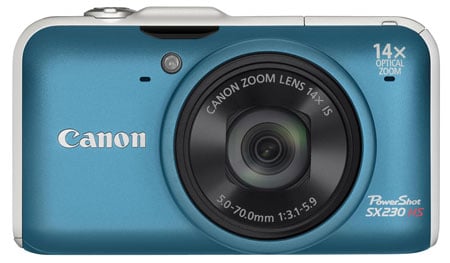 |
Canon PowerShot SX230 HS Design and controls
The PowerShot SX230 HS looks similar to to its predecessor and is almost exactly the same size and weight. It’s available in pink, blue or black and the soap bar shape with a cupped silver edge both looks stylish and provides a secure and stable grip. The tell-tale difference between the SX230 HS and its predecessor is the bulge on the top edge just to the left of the shutter release labelled GPS. There’s one other important difference: the earlier SX210’s zoom ‘nipple’ experiment has been abandoned with the return of a conventional zoom collar surround on the shutter release.
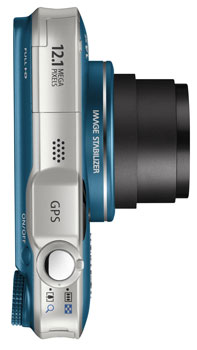 |
The stereo mics have been relocated from the top to the front panel and the movie button no longer doubles a custom function button and that’s the extent of the external changes.
The Flash on the PowerShot SX230 HS is a pop-up type located on the left end of the top panel. Regardless of the settings, even if it’s disabled or you’re in a movie exposure mode, it pops up when the camera is powered on, which is a bit of a nuisance, but it’s easily pushed back into position. The problem is you then have to pop it back up manually if you want to use it – even in auto mode and I think that’s simply poor design. How else would you describe a system that automatically activates when not required and vice versa? It’s also something just about every review criticised on the earlier SX210 IS, so it’s disappointing not to find it resolved here.
The flash has ‘Auto’ (fires when required as long as you remembered to pop it up) forced on, forced off (superfluous as popping it down does the same thing) and slow synchro modes, and has a quoted maximum distance of 3.5 metres. Smart flash automatically adjusts power depending on the proximity and brightness of the subject and recycles in around two to four seconds.
The SX230 HS has a 3in widescreen display with 16:9 proportions. While ideal for shooting HD movies, best-quality 4:3 stills only occupy the central portion of the screen with thick black bars containing info icons running down either side. But if you’re shooting lots of HD video, it’s great. With much of the competition opting for 4:3 screens this is something that sets the SX230 HS apart and along with 1080 24p HD video will increase its appeal for film makers. The 460k dot resolution results in a crisp detailed image that’s bright, contrasty and easy to see from most angles though in bright sunlight, like all screens, it’s a bit of a struggle.
 |
The controls, including the mode dial, dedicated movie record button playback, display and menu buttons and the control wheel are located to the right of the screen on a subtly contoured panel that looks cramped, but, perhaps due to the contoured surface, doesn’t feel so.
The on/off button is positioned on the bevelled top edge just above the mode dial. The only slightly unusual thing about the controls is the control wheel’s lack of labels. The wheel doubles up as a menu navigator – rotate to scroll – and a four-way one-touch selector for flash, self-timer, macro and exposure compensation, an icon showing the layout appears on the screen when the wheel is lightly pressed – a great idea once you get used to it.
A flap on the right edge covers the mini HDMI and A/V / USB ports and the combined card and battery compartment on the bottom of the camera takes SD (HC XC) cards. The NB-5L battery pack provides enough power for an unimpressive 210 shots. With the optional WP-DC42 waterproof casing you can dive with the SX230 HS to a depth of 40 metres.
Canon PowerShot SX230 HS lens and stabilisation
The PowerShot SX230 HS has a 14x stabilised optical zoom with a 35mm equivalent range of 28 – 392mm. It’s the same lens with the same field of view as it predecessor and, like the SX210 before it, the SX230 HS lacks the super-wide angle field of view provided by competitor models like the Sony Cyber-shot HX9V, Panasonic Lumix TZ20 / ZS10 and Nikon COOLPIX S9100. But where the earlier SX210 could outreach its competitors at the telephoto end of the range that’s no longer the case with the latest PowerShot SX230 HS, as its telephoto advantage over the HX9V and TZ20 / ZS10 is negligible and the COOLPIX S9100 outguns it with a 450mm telephoto.
Canon PowerShot SX230 HS coverage wide |
Canon PowerShot SX230 HS coverage tele | |
 |  | |
| 5-70mm mm at 5mm (28mm equivalent) | 5-70mm at 70mm (392mm equivalent) |
While a slightly wider field of view would be nice, the PowerShot SX230 HS nonetheless provides an impressive zoom range in a pocketable format. The zoom is smooth and quiet and the two-speed zoom collar provides a good degree of control. Optical image stabilisation has four still image modes – off, continuous, Shoot only and panning.
Canon’s optical image stabilisation has proved to be very effective on earlier models and the claim of four stops of stabilisation for the PowerShot SX230 HS is perfectly credible. I tested the SX230 HS stabilisation by taking a series of shots with the lens set to its maximum focal length with the stabilisation turned off and set to Continuous. The crops below show the results.
Canon PowerShot SX230 HS, IS Off / Continuous | ||||
 | 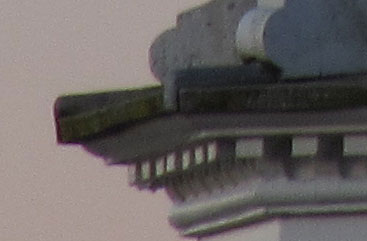 | |||
100% crop, 5-70mm at 70 mm, 1/20, 100 ISO, IS Off. |
100% crop, 5-70mm at 70 mm, 1/20, 100 ISO, IS Continuous. | |||
Canon PowerShot SX230 HS shooting modes
The SX230 HS’s mode dial provides a good guide to the available shooting modes with the manual and semi-automatic PASM modes followed by Auto with scene detection and Easy auto which disables all the advanced functions leaving basic point-and-shoot operation. Next there’s the new Movie digest mode which continuously buffers a few seconds of video allowing a four second clip of the action immediately preceding a still shot to be saved; these clips are then compiled into a digest of the day’s events – a genuinely novel and creative application of modern digital processor technology.
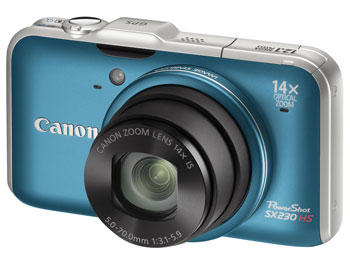 |
The SX230 HS’s scene detection can determine whether there are people in frame, the lighting conditions, distance from the camera and whether subjects are moving; it then displays an icon to let you know what it thinks its looking at and sets the focus and exposure accordingly. It’s reassuringly accurate and rarely gets it wrong, though if it can’t make a decision it defaults to the regular auto exposure metering. The SX230 HS can also tell when you’ve got the camera attached to a tripod and unlock longer exposure times.
Next up are a selection of dedicated scene presets followed by the generic SCN position with on-screen selection of 12 further scene modes. Most notable of these are Handheld Night Scene which takes several frames in low light and produces a composite image with lower noise, Smart shutter with smile activation and wink and face self-timer modes, and a reduced resolution High speed burst mode, about which more later.
Like most other 2011 Canon compacts the PowerShot SX230 HS features the new Creative filter modes, special effects that include faux fish-eye, miniature (tilt-shift), Toy camera (vignette), Super vivid, Poster, Colour accent and Colour replace effects. All good fun and an a quick and easy route to effects for those who lack the time or inclination to post process their images.
Canon PowerShot SX230 HS movie modes
The SX230 HS has a dedicated movie mode button so you can record video regardless of the position of the mode dial. Some stills modes, including all of the Creative filter and many scene modes, can also be used for movie shooting. In Miniature mode the action is sped up and you can choose one of three playback speeds. There’s also a movie position on the mode dial which switches the screen to 16:9 view and sets the shooting mode to standard. Movie exposure is set automatically but you can lock it prior to shooting and adjust by up to two stops either way.
The PowerShot SX230’s best video mode is 1920 x 1080p, at 24 fps an improvement on the 720p resolution of it’s predecessor and one which will certainly please film makers who favour not just the Full HD resolution, but the 24fps frame rate. Other options include 720p, VGA and QVGA, all at 30fps. The maximum recording time for HD clips is 4GB or a second short of half an hour, whichever comes first. At the 1080p24 resolution the data rate is around 38 Megabits per second which equates to about 15 minutes of footage on a 4GB card, and Canon recommends SD speed class 6 or higher cards.
Movies are encoded using the H.264 codec and saved in a QuickTime wrapper as .mov files. There’s also an iFrame option that produces files in Apple’s easily edited iFrame format as well as a Super slow motion mode that shoots at 120 fps VGA and 240 fps QVGA.
The PowerShot SX230 HS has Dynamic IS movie stabilisation which can be turned off, but it’s probably not a good idea, particularly if you plan to use the optical zoom which can be operated during filming. Though you can’t take stills during movie recording, you can shoot stills with the mode dial in the movie position, but pressing the shutter release while filming stops recording.
| |
|---|---|
|
Other than a little bit of flare and wind noise, (for which there’s a filter) this 1080p24 clip from the PowerShot SX230 HS looks very nice. The focus is spot on throughout the handheld zoom and image stabilisation, though it doesn’t iron out all the wobbles, is a big improvement on unstabilised hand-held footage.
| |
|---|---|
|
On this tripod-mounted panning shot the PowerShot SX230 HS loses the focus momentarily near the end of the zoom, but quickly regains it. If you listen carefully you can just hear the zoom motor.
| |
|---|---|
|
There’s a little bit of noise visible in this low-light hand-held panning shot, but the quality is nonetheless very good. The metering is quick to respond to the changing lighting, but exposure can be locked-off if you prefer.
Canon PowerShot SX230 HS handling
The PowerShot SX230 HS starts up in around one and a half seconds extending the three-section zoom to 24mm. Zoomed to its full telephoto range the barrel extends to an impressive 51mm. We’ve already talked about the efficiancy of Canon’s scene detection and its Face AiAF system is no less capable. In the absence of faces it defaults to single centre area AF and you can reduce the size of the AF area for spot focussing or select tracking AF for non-human moving subjects.
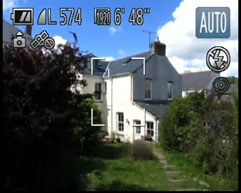 |
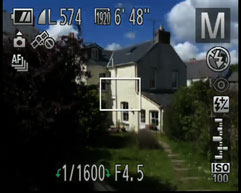 |
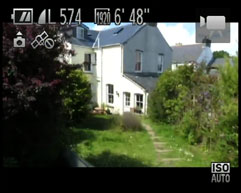 |
The Func menu, activated from the control wheel central button almost negates the need to access the two-tabbed menu system and is logically organised providing only the relevant controls for the selected exposure mode.
In continuous shooting mode the PowerShot SX230 HS can manage 2.2fps at full resolution- a little slower than the quoted 3.2 fps. In the High speed burst mode, however, it manages a much more respectable 6.5fps, albeit at a reduced 3M (1984 x 1488) resolution.
The PowerShot SX230 HS has a built-in GPS receiver which appends geopositional data to the image and can also produce a track log that can be plotted on a map, though in this mode the GPS is always on and consequently drains the battery more quickly. In use the GPS wasn’t always able to lock onto a sufficient number of satellites to provide positional data and on occassions the data it did provide wasn’t particularly accurate, sometimes varying from the actual position by tens of metres.
The PowerShot SX230 HS has a 12.1 Megapixel CMOS sensor which produces images with a maximum size of 4000 x 3000 pixels at one of two compression settings. The best quality Fine setting produces images with a file size of around 3MB.
To see how the quality of the PowerShot SX230 HS measures-up in practice, take a look at our real-life resolution and high ISO noise results pages, browse the sample images gallery, or skip to the chase and head straight for our verdict.




